Zhu Xiaomin
Department of Philosophy, Peking University / Research Center for Science Communication, Peking University, 100871
Living in Valley Tents: First Encounter with Orsolina28
In late June 2025, I joined several colleagues from the Department of Physical Education and other units at Peking University to form a Taiji team for a visit to the Orsolina28 Art Foundation in Italy. Last November, several of the foundation’s key members had already come to Peking University for a seminar organized by the Office of International Relations. They attended my class “Traditional Taijiquan: Philosophy and Practice” and expressed interest in exploring how Western dance and Taiji might be brought together. This one-week visit was thus an opportunity for both sides to deepen mutual understanding and refine our plans for collaboration.
Our plane landed at Milan Airport on Sunday evening, the 22nd. After another hour and a half by car, it was nearly midnight when we arrived at our destination. Each of us was given a large tent, and by coincidence, mine was No. 28. Exhausted from the journey and the time difference, I washed up quickly and fell asleep at once. Through the night, I faintly heard the ceaseless croaking of frogs, and at dawn, I awoke to a melodious chorus of birds. Sunlight streamed through the bright skylight, filling the tall, spacious, ochre-yellow tent. For a moment, I almost imagined Genghis Khan riding across Eurasia in his Great Khan’s yurt, banners flying and horses thundering over thousands of miles.
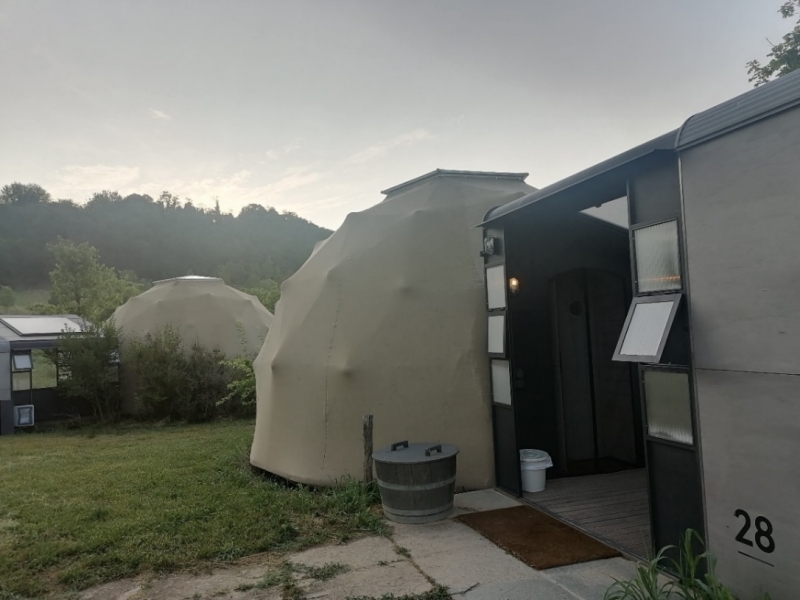
The author’s Tent No. 28 at Orsolina28, surrounded by vineyards, orchards, and greenery.
On the way from my tent to the dining hall, I could roughly take in the layout of the Orsolina28 Art Foundation. Its various buildings and studios are scattered harmoniously across an open valley, interspersed with vineyards, orchards, vegetable plots, meadows, and small ponds. Climbing to a higher point and gazing into the distance, one can see the rolling green hills unfolding like a magnificent painting—truly a living embodiment of the saying, “Green mountains, though uninked, are eternal paintings.”
Anna Aglietta, the Foundation’s Head of Community and Communications, welcomed us warmly. She first gave us a tour of the major facilities and their functions, then carefully arranged our week-long program. During our stay, we not only taught Taiji courses and engaged in interactive sessions with local enthusiasts and two international dance troupes visiting that week, but also joined activities normally offered to guest dancers. These included yoga, ballet, Pilates, gravity class and, aquagym, as well as observing the rehearsals of the two dance troupes, and having a tour of the gardens. Such a program undoubtedly deepened our mutual understanding and laid the groundwork for further concrete collaboration.
It also became clear that the Orsolina28 Art Foundation is dedicated to fostering international exchange and mutual learning in dance, while at the same time introducing diverse cultural elements to broaden dancers’ horizons and perspectives. It is precisely in this context that Taiji met Western dance.
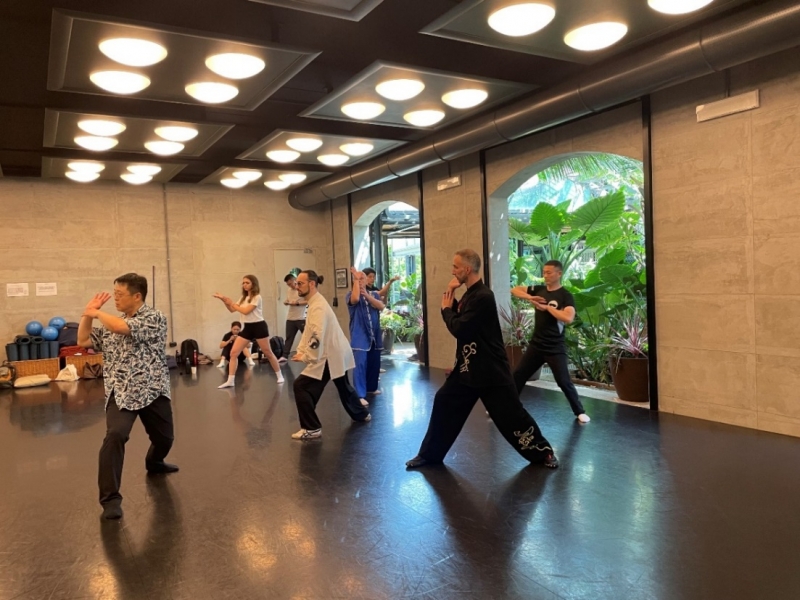
The author teaching Taiji in a studio where one wall opens directly to nature.
The Orsolina28 Foundation is located in the small town of Moncalvo, situated almost midway between Milan and the regional capital, Turin. On the third day, Anna personally accompanied us on a sightseeing trip to Turin, about an hour’s drive away. Along the way, vast fields of ripening golden barley stretched into the distance. It occurred to me that the nightly chorus of frogs might well be echoing the poetic line, ““In the fragrance of rice blossoms, talk turns to a bountiful year.”
Turin’s Egyptian Museum (Museo Egizio), established 200 years ago, is the largest collection of Egyptian antiquities outside Egypt. It houses 5,000-year-old mummies, 3,000-year-old fruit (which looked surprisingly like still-edible potatoes), and an impressive array of statues and sarcophagi of the pharaohs. What struck me as curious was that several of the sphinxes bore distinctly delicate, Oriental features. Our guide explained that in ancient times, people often regarded Eastern faces as embodying a greater sense of beauty. At lunch, Anna introduced us to Turin’s local cuisine. Most memorable were the small, square, brown ravioli—shaped like ancient Chinese coins, shrunken and seemingly hollow, to be eaten with cheese. They were a world apart from our thin-skinned, generously stuffed dumplings.
As Still as Blossoms Unfolding, As Swift as Thunderclaps: The “Shock” of Taiji
Our Taiji team demonstrated a variety of practices and routines, including Chen-style, Simplified 24-form, Yang-style and, Wu/Hao-style Taijiquan, as well as some movements from the Baduanjin (‘Eight -section Brocade’, a type of Qigong that consists of eight, gentle flowing exercises that combine movement, breathing, and mental focus). Chen-style Taiji, with its explosive bursts of power and spiraling, unpredictable grappling techniques, often brought the interactive sessions to their climax. From the perspective of Yang-style and Wu-style, I emphasized that body movements should expand outward from within—like flowers blooming—naturally and harmoniously, without unnecessary muscular tension, so that internal energy could circulate smoothly, and that “if one part moves, all parts respond.”
Lu Xun once remarked that Mei Lanfang’s dance was “dance without jumping”—a reflection of Chinese art’s focus on spirit over form, on capturing the essence with minimal external display(similar to Taijiquan’s principles such as inside is more important than outside, and smaller movements are better than bigger ones, etc.). He criticized the younger generation’s dancing as “jumping without dancing,” overly exaggerating outward movement to the point of overshadowing or obscuring the inner meaning. This suggests that dance, too, seeks something inward, and is not merely the pursuit of external display.
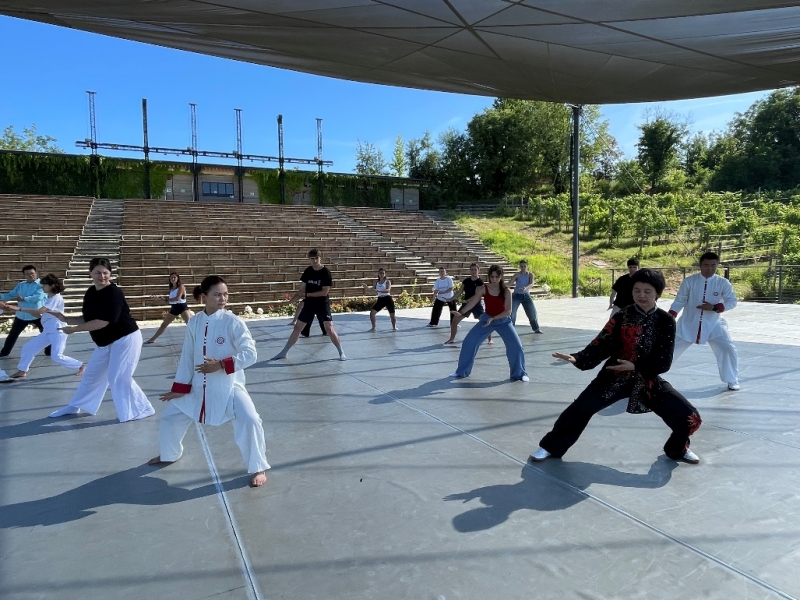
The visiting team members teaching Taiji together
That week, two international dance troupes were visiting the Orsolina28 Foundation. Ms. Yueyin, director of the YYDC troupe, said her dancers were completely “shocked” by the Taiji demonstrations and workshops. Peter Chu, the choreographer of the other troupe, told us that he had practiced Yang-style Taiji for seven years. He spoke candidly of how the Eastern philosophy embodied in Taiji had been a source of inspiration and guidance for him, and how it had even profoundly shaped his international career as a choreographer.
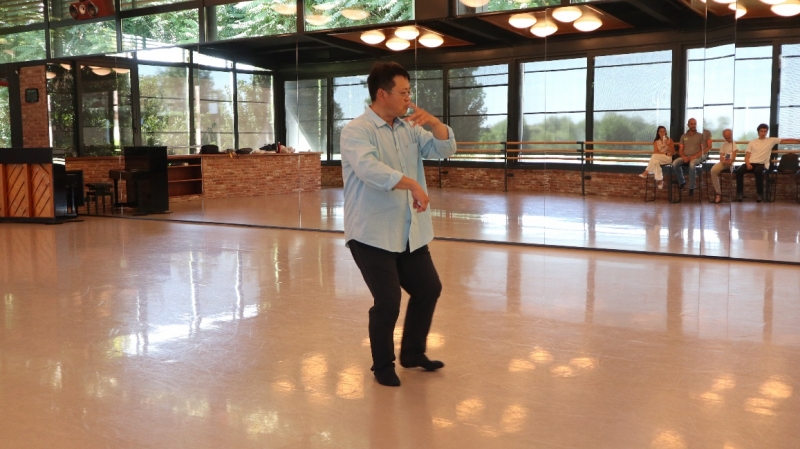
The author demonstrating Wu/Hao-style Taiji.
When Taiji Meets Western Dance: Returning to Nature, Opening Dialogue
During our discussion, the Foundation’s Co-Founder and Councilor, Michele Denegri, shared his candid reflections. He noted that much of today’s Western modern dance is conceived and performed within the concrete confines of large cities. Such cramped spaces, he argued, not only increasingly confine choreographers’ and dancers’ imagination, performance, and visions for the future of modern dance, but also gradually restrict audiences’ ability to accept, appreciate, and inwardly connect with it. His vision, therefore, is for modern dance to return from the metropolis to nature, to once again draw inspiration from it—for, in his words, nature will ceaselessly provide what is truly “new.”
No wonder all visitors to Orsolina are housed in all sorts of “down-to-earth” tents. Most of the power lines along the paths are buried underground, and the streetlights are hung from tree branches. At night, their glow casts shifting shadows of leaves, turning the valley into a spectacle of light and foliage, enchanting in its own way. Many of Orsolina’s studios either have only a roof or are missing a wall, ensuring constant openness and connection with nature. Our Pilates class, for instance, was held in a forest clearing; during practice, one teacher from the Department of Physical Education was stung by a bee, prompting good-natured jokes about his “irresistible charm” for bees and butterflies.
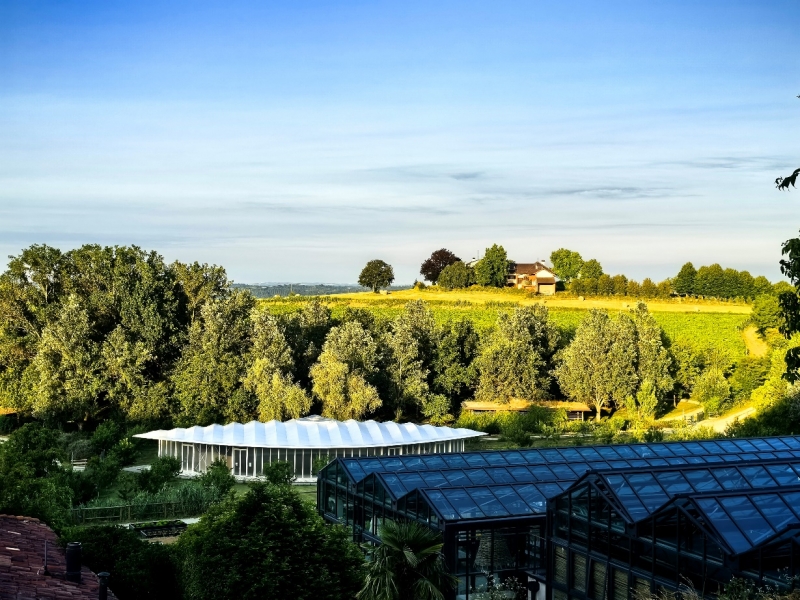
The white training hall nestled in the valley of Orsolina28.
The dining hall serves vegetables and fruits three times a day, many of which—like the wine that flowed freely after Saturday’s final showcase performance—are grown and produced on site. Visiting dancers sometimes take part in gardening activities. During a tour of the gardens, we sampled cucumbers, tomatoes, and mulberries straight from the vines and branches. There was even a small chicken farm, likely the source of the scrambled eggs (omelets) that appeared at breakfast every day. The canteen offered a different menu each day, featuring distinctive local flavors. Regrettably, the original and authentic Italian pizza that everyone longed for never made it to the table during the whole week of our stay. Almost all the roads and paths throughout the valley were gravel or dirt, so a casual stroll was enough to leave a fine dust on one’s leather shoes—an ever-present reminder that we were cradled in Mother Earth’s embrace. Clearly, every aspect of the Foundation’s arrangements in this natural valley was full of thoughtful design, carrying a flavor of returning to nature and the Daoist ideal of “the unity of heaven and humanity.”
Secondly, Back to Michele. He went on to emphasize that Western modern dance must remain in constant dialogue with the outside world. From April to November, the Foundation hosts visiting dancers, choreographers, and their students from around the globe almost every week. These guests not only revisit and reflect upon the traditions of Western classical ballet while engaging in strength training and water aerobics, but also learn from other cultures and civilizations—such as yoga, Pilates, and now, soon to be added to the program, Chinese Taijiquan. Michele even expressed his hope that the harmony and inclusiveness embodied in Taiji could serve as a living ex
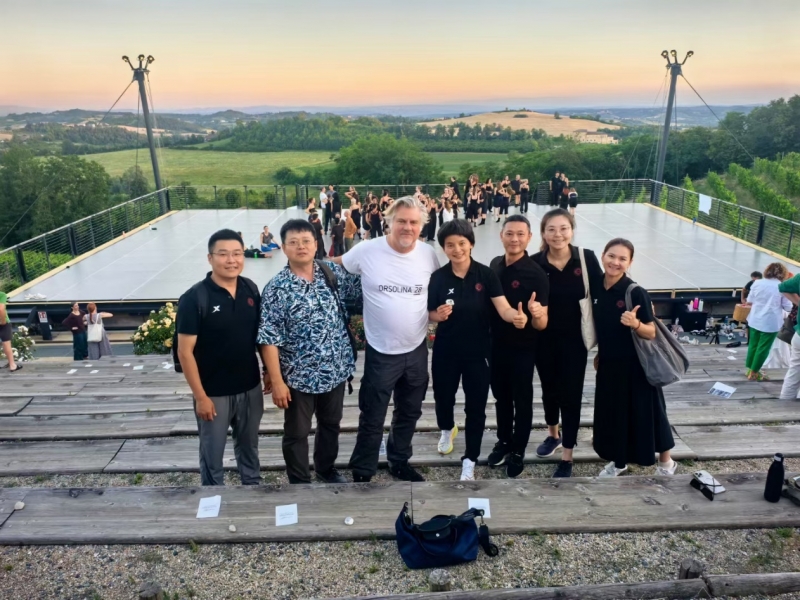
After Saturday evening’s outdoor performance at Orsolina28, the visiting team took a group photo with Michele.
On Saturday evening, the 28th, the two international dance troupes performed on Orsolina’s open-air stage, set against the vast backdrop of nature, showcasing the works they had choreographed during their week-long stay. Every Saturday, hundreds of local community residents are invited to watch these performances free of charge. The Foundation’s Secretary General, Andrea Limone, personally hosted the event. In a private conversation with him, I couldn’t help but reflect: behind every form of dance—every ex
After the performance, all of the week’s visitors gathered in the dining hall for a communal meal. Glasses clinked, conversations flowed, and before long, many people had taken to the floor, freely expressing themselves through joyful dance. The atmosphere reached its peak of delight. I couldn’t help but hope that, one day, traditional Taiji too might have the chance to be performed on Orsolina28’s grand open stage under heaven and earth.
The Foundation had also thoughtfully arranged two diligent and dependable Chinese-language assistants for us. Both were graduate students in international relations, having majored in Chinese at the University of Turin, and both had visited China many times. The young man, Lin Kaiyan (Folco Ferraris), was even the national champion of the “Chinese Bridge” competition in Italy, while the young lady, Ai Yinglian (Ilenia Aly), will spend the coming year at Zhejiang University. Their passion for Chinese culture was evident; one evening, they even joined me in practicing Yang-style Taiji. Ai Yinglian expressed a strong wish to pursue her doctorate at Peking University in the future and to continue learning and practicing traditional Taiji. I sincerely hope her dream comes true.
This article is published as following: Xiaomin Zhu, When western dance meets Chinese Taiji, World Vision, No. 17, Sept. of 2025, pp 52-55